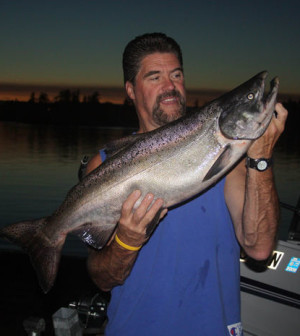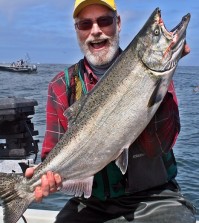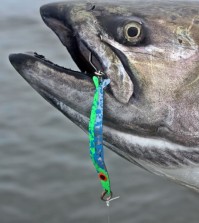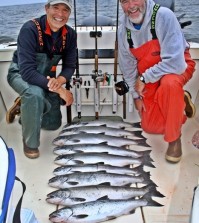Chinook: Timing is Everything

One of the biggest musical hits of the late-sixties was an instrumental entitled Time is Tight, performed by Booker T and the MGs. Booker T and the boys were out of Memphis, so when it comes to Pacific salmon it’s unlikely they knew their adipose from their elbows, but the title of their little instrumental diddy could be the mantra of savvy West Coast salmon anglers, especially those in search of big, mature Chinook.
Time is, indeed, tight, when you’re fishing for kings, because the bigger and closer to spawning time they get, the more finicky they become about when they eat, so a full day on the water may provide anglers with less than an hour of productive fishing. If you’re not in the right place and doing the right thing when those windows of angling opportunity open, you could be out of luck.
Did I say luck? Successful salmon anglers make their own luck by being in the right places at the right times and making the most of those short periods when the bite is on. Mature kings, unlike other salmon species and even immature Chinook, are finicky about where, when and how they feed. Catching kings requires using all you know and then some.
While Chinook that are still “pasturing” out in the open ocean may feed and chase bait throughout much of the day and throughout much of the water column, the species’ feeding habits become more selective and the places they feed more limited as fish mature and move toward the freshwater streams of their origin. As these fast-maturing adult Chinook become more interested in reaching their final destination than in eating, catching them becomes more and more challenging. This principle applies to adult Chinook entering the estuaries of the California and Oregon coasts, just as it does in the so-called “inside” waters of Washington’s Strait of Juan de Fuca and northern Puget Sound.
With mature Chinook that are moving toward their home streams, the bite for an entire day may last five minutes, 15 minutes, maybe as long as two hours if you’re really lucky, so being in the right place when it happens is critical to success.
One of the “right times” to fish for kings is early morning. Northwest salmon anglers, for the most part, know that king salmon usually bite best at daylight, but many aren’t in a position to fish at those times. Just launching your boat at first light isn’t the same as being in your fishing spot with baited hooks in the water at first light.
Well-known Northwest salmon-chaser Tony Floor likes to tell the story about how being on the water early put him in position to boat the biggest king of his life. “It was a 53-pounder, and I hooked it as the very first hint of pink was beginning to show on the horizon; the rest of the sky was still dark,” he says. It’s a safe bet that many salmon anglers were just launching their boats or motoring out of the harbor as Floor slid the net around his trophy-class king.
Longtime Seattle Post-Intelligencer outdoor writer Blaine Freer liked to quote “Haw’s Law” in describing the importance of fishing for Chinook salmon during that all-important first crack of dawn. Frank Haw was a former Washington Department of Fisheries biologist and Northwest salmon-fishing guru, and his law, as espoused by Freer, was “If you can see the bait, it’s too late.” It doesn’t get much simpler than that; if you’re just hitting the water at daylight, you’ve already missed your best opportunity of sinking the hook into a big Chinook salmon. You should be baiting your hooks in the dark in order to take full advantage of those first few precious seconds of daylight.
By now you’re probably starting to realize that if you’re a late sleeper, you’re usually going to miss your best chance of the day to put a bragging-size king in the boat. The good news is that first light isn’t your only chance. Tide changes during the day also spur Chinook salmon feeding activity, as does the day’s second low-light “magic hour,” just before dark.
“If you don’t score during the morning bite, your best shot at getting Chinook to bite is fishing the tide and current change,” says Floor. “The best time is when the current begins to slow and change, on either side of the tide (ebb or flood). The length of time for this bite will vary depending on the extent of the tide and the geography.”
Tide changes draw baitfish together in tight concentrations, and where baitfish congregate, adult Chinook come to feast!
The best combination of tide and time depends on where you’re fishing, but a current speed of about one knot is ideal. Stronger current makes it more difficult to fish effectively.
Some salmon anglers believe a flooding tide offers the best chance for Chinook, others swear by the ebb, and both are right. It depends on where you’re fishing.
Understanding the geography is the main thing. You have to know how the bait reacts to the moving water on which tide. With rare exceptions, you want to fish downhill with the current, going deeper as the water moves you along. Whichever tide carries you from shallower water into deeper water is usually the best fishing tide in that location.
As a general rule, the time of day they’re least likely to bite is when the tide is dead-slack. Baitfish schools disperse when the tide is slack, and so do the salmon.
Luckily for salmon anglers, we can all get our hands on tide and current tables that tell us in advance when these events will happen virtually anywhere we might plan to fish. Unlike salmon fishing, tides and currents are pretty much an exact science, so there’s no excuse for not knowing when and where they’ll happen on any given fishing day.
The day’s last flurry of Chinook-fishing activity occurs during the final hour of daylight, and it may provide fishing that’s every bit as good as the early-morning bite. A tide change during the final 30 minutes of daylight can be especially productive. Again, though, that means hanging in there through last light, and being prepared for night-running back to the boat ramp or dock. Be sure your boat and your boating skills are up to it.
The success of early morning and late-evening Chinook anglers might beg the question; do these feeding sprees last through the night? The answer is usually “yes,” but few anglers capitalize on the possibilities.
“There’s pretty good evidence that those salmon you fish for at last light and again at first light are actively feeding throughout the night,” Tony Floor says. A man named Art Gallaghan, who retired from Washington’s Department of Fisheries years ago, liked to launch at 8 p.m. and come in about 6 a.m., and he caught fish all night.”
If you haven’t tried it, though, that kind of fishing is very challenging. You can’t see your line angle, so you don’t always know where you’re fishing or where a hooked fish really is, you can’t see fish to net them, can’t see that tell-tale twitching of the rod tip on a light strike. That’s not to mention the deadheads and other dangers you might encounter when you’re out there all alone in the darkness.
There’s another aspect of timing that’s very important to salmon anglers. Besides being on the water with bait on your hooks at the right times of day, you also have to be fishing the right general areas at the right time of year, and some anglers ignore those details.
“State fish and wildlife agencies along the Pacific Coast have years of statistics that show the timing of various salmon runs through our ocean,” Floor says. “For example, populations of Columbia River kings passing through Neah Bay, Washington, peak in July. We also know, on a year-to-year basis, when that trip to Neah Bay is probably going to be worthwhile and when it might not be so good. You have to know the run forecast and how it will affect the fishing. Similarly, 90 percent of the Chinook salmon caught off the SW corner of Vancouver Island are bound for Oregon and Washington, and those runs peak in June. So, be in Tofino in June for some pretty good Chinook fishing.
Such run-size and timing information is available for Chinook runs along the entire coast, and it’s a good idea to study several years’ worth to see how the patterns emerge.
But don’t just start thinking about all this in July to plan your summer fishing trips. Do your homework well ahead of time so that you can time your future vacations and fishing trips for the right places at the right times.










